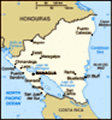Nicaraguan Economy, Nicaragua Economy
Advertisement
Economy - overview: Nicaragua, one of the hemisphere's poorest countries, faces low per capita income, massive unemployment, and huge external debt. Distribution of income is one of the most unequal on the globe. While the country has made progress toward macroeconomic stability over the past few years, GDP annual growth has been far too low to meet the country's needs. As a result of successful performance under its International Monetary Fund policy program and other efforts, Nicaragua qualified in early 2004 for some $4 billion in foreign debt reduction under the Heavily Indebted Poor Countries (HIPC) initiative. Even after this reduction, however, the government continues to bear a significant foreign and domestic debt burden. If ratified, the US-Central America Free Trade Agreement (CAFTA) will provide an opportunity for Nicaragua to attract investment, create jobs, and deepen economic development. While President BOLANOS enjoys the support of the international financial bodies, his internal political base is meager.
GDP: 0.7% (2004)
GDP - real growth rate: 4% (2004 est.)
GDP - per capita: Purchasing power parity - $2,300 (2004 est.)
GDP - composition by sector: Agriculture: 20.7% industry: 24.7% services: 54.6% (2004 est.)
Population below poverty line: 50% (2001 est.)
Household income or consumption by percentage share: Lowest 10%: 1.2% highest 10%: 45% (2001)
Distribution of family income - Gini index: 55.1 (2001)
Inflation rate (consumer prices):
Labor force: 1.93 million (2004 est.)
Labor force - by occupation: Agriculture 30.5%, industry 17.3%, services 52.2% (2003 est.)
Unemployment rate: 7.8% plus underemployment of 46.5% (2003 est.)
Budget: Revenues: $725.5 million expenditures: $1.039 billion, including capital expenditures of NA (2004 est.)
Industries: Food processing, chemicals, machinery and metal products, textiles, clothing, petroleum refining and distribution, beverages, footwear, wood
Industrial production growth rate: 4.4% (2000 est.)
Electricity - production: 2.553 billion kWh (2002)
Electricity - production by source:
Electricity - consumption: 2.318 billion kWh (2002)
Electricity - exports: 6.8 million kWh (2002)
Electricity - imports: 15.3 million kWh (2002)
Oil - production: 0 bbl/day (2003 est.)
Oil - consumption: 25,770 bbl/day (2003 est.)
Oil - exports: 738 bbl/day (2003)
Oil - imports: 27,950 bbl/day (2003)
Oil - proved reserves:
Natural gas - production:
Natural gas - consumption:
Natural gas - exports:
Natural gas - imports:
Natural gas - proved reserves:
Agriculture - products: Coffee, bananas, sugarcane, cotton, rice, corn, tobacco, sesame, soya, beans; beef, veal, pork, poultry, dairy products
Exports: $750 million f.o.b. (2004 est.)
Exports - commodities: Coffee, beef, shrimp and lobster, tobacco, sugar, gold, peanuts
Exports - partners: US 64.8%, El Salvador 7%, Mexico 3.6% (2004)
Imports: $2.02 billion f.o.b. (2004 est.)
Imports - commodities: Consumer goods, machinery and equipment, raw materials, petroleum products
Imports - partners: US 22.6%, Costa Rica 8.5%, Venezuela 8.4%, Guatemala 6.8%, Mexico 5.8%, El Salvador 4.9%, South Korea 4.5% (2004)
Debt - external: $4.573 billion (2004 est.)
Economic aid - recipient: $541.8 million (2003)
Currency:
Currency code:
Exchange rates: Gold cordobas per US dollar - 15.937 (2004), 15.105 (2003), 14.251 (2002), 13.372 (2001), 12.684 (2000)
Fiscal year: Calendar year
Advertisement
The information here has been derived from Public Domain Sources such as the CIA World Factbook. No liability can be taken for any inaccuracies.
Tot: 0.034s; Tpl: 0.008s; cc: 3; qc: 2; dbt: 0.0105s; 1; m:domysql w:travelblog (10.17.0.13); sld: 1;
; mem: 1.1mb

 The Pacific Coast of Nicaragua was settled as a Spanish colony from Panama in the early 16th century. Independence from Spain was declared in 1821 and the country became an independent republic in 1838. Britain occupied the Caribbean Coast in the fir...
The Pacific Coast of Nicaragua was settled as a Spanish colony from Panama in the early 16th century. Independence from Spain was declared in 1821 and the country became an independent republic in 1838. Britain occupied the Caribbean Coast in the fir...
